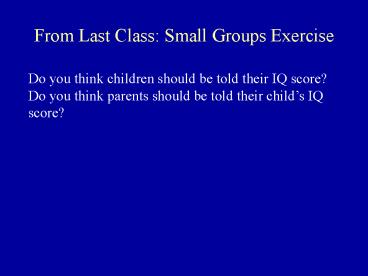From Last Class: Small Groups Exercise - PowerPoint PPT Presentation
1 / 18
Title:
From Last Class: Small Groups Exercise
Description:
Identical twins reared together: .86. Identical twins reared apart .76 ... child (rather than a neutral relationship that is identical for all children ... – PowerPoint PPT presentation
Number of Views:21
Avg rating:3.0/5.0
Title: From Last Class: Small Groups Exercise
1
From Last Class Small Groups Exercise
Do you think children should be told their IQ
score? Do you think parents should be told their
childs IQ score?
2
Intelligence Lecture (Contd)
- Ethnic and Socioeconomic Variations in IQ
- Explaining Individual and Group Differences in
IQ - Development of Creativity
3
Ethnic and Socioeconomic Variations in IQ
Socioeconomic status A measure of a familys
social position and economic well-being that
combines 3 inter-related, but not completely
overlapping, variables 1) years of education 2)
the prestige of and skill required by ones job
and 3) income, which measures economic status
4
Genetic Influences
- Identical twins reared together .86
- Identical twins reared apart .76
- Fraternal twins reared together .55
- Fraternal twins reared apart .35
- Siblings reared together .47
- Siblings reared apart .24
5
Test Bias
- If a test samples culturally specific knowledge
and skills that not all groups of children have
had equal opportunity to learn, then it is a
biased, or unfair measure
6
Test Bias
- Language Customs
- Ethnic minority families often foster unique
language skills that dont match the expectations
of most classrooms and testing situations
7
Test Bias
- Test Content
- Researchers argue that IQ scores are affected by
specific information acquired as part of
majority-culture upbringing
8
Test Bias
- Testing Conditions
- Testing conditions may favour certain ethnic
groups over others
9
Reducing Test Bias
- Dynamic Testing An approach to testing in which
purposeful teaching is introduced into the
testing situation to find out what the child can
attain with social support - 3 Factors that Differentiate this Approach
- A focus on the processes involved in learning and
development (rather than on intellectual
products) - Provision of feedback after each task (rather
than no feedback) - An examiner-child relationship based on teaching
and helping that is individualized for each child
(rather than a neutral relationship that is
identical for all children
10
Home Environmental Factors
Shared environmental influences Factors that
pervade the general atmosphere of the home and as
a result similarly affect all children living in
it (e.g., parental modeling of intellectual
activities Non-shared environmental influences
Factors that affect one sibling differently from
another (e.g., birth order and spacing)
11
Development of Creativity
Creativity The ability to produce work that is
original (that others have not thought of before)
and that is appropriate (sensible or useful in
some way)
12
Development of Creativity
Divergent Thinking The generation of multiple,
unusual possibilities when faced with a task or
problem associated with creativity Convergent
Thinking The generation of a single correct
answer to a problem the type of cognition
emphasized on intelligence tests
13
Development of Creativity
Investment Theory of Creativity Investing in
novel projects depends on diverse cognitive,
personality, motivational, and environmental
resources, each of which must be present to
catalyze creativity.
14
Development of Creativity
- Cognitive Resources
- Problem-finding
- Ability to define the problem
- Alternating between divergent and convergent
thinking - Reliance on insight processes
- Evaluating competing ideas
- Knowledge
15
Development of Creativity
- Personality Resources
- Innovative style of thinking
- Perseverance and tolerance of ambiguity
- Willingness to take risks
- The courage of ones convictions
16
Development of Creativity
- Motivational Resources
- Task focused rather than goal-focused
17
Development of Creativity
- Environmental Resources
- Family life focused on the childs needs
- Challenging school environment
18
Video
- Acquiring the Human Language Playing the
Language Game

